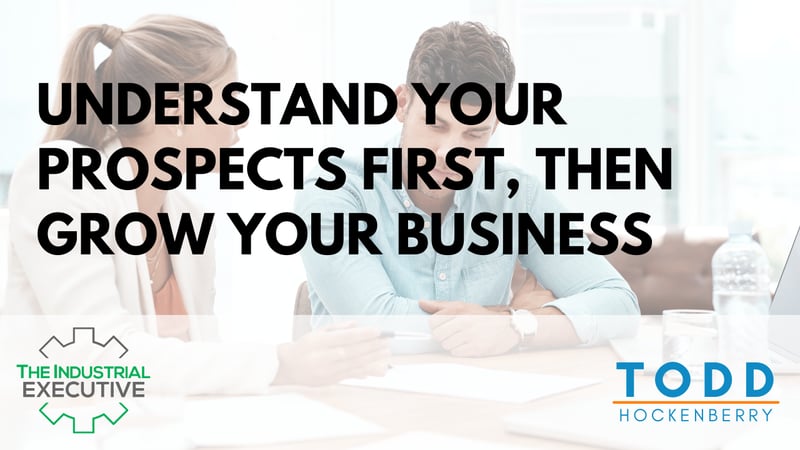Posted by Todd Hockenberry ● Oct 04, 2022
Understand your prospects first, then grow your business.
Talk to your prospects and customers about the buying process from their point of view.
Sounds simple, like, of course, we should do that. I am still surprised at how few manufacturing companies do this step. You need to develop insights into what your prospects think about a great buying experience, not what your salespeople say it is.

Last week I talked about my car dealer not caring about my needs or goals.
This past week, I conducted a series of interviews for a client. I was fortunate to be able to talk to a lost prospect.
When I asked the lost prospect what the most important criteria were for buying this piece of capital equipment, he said - price, delivery, and service.
Sounds about right. But when I dug in, the prospect revealed the real buying decision reason.
He said he would have chosen our client if they could have delivered the equipment in a shorter time frame. OK, so it was delivery that was the highest value.
When I dug in further and asked about the price, he told me my client was $40,000 higher than the company he ultimately chose. He said he would have preferred my client if they could have delivered on a shorter schedule.
Now he had my attention! I asked why he would pay a premium for a piece of equipment that was technologically equal to the less expensive ones.
He said that my client's service location and capability were far superior to the other choices and were worth a price premium for the equipment.
The primary value for this purchase was service. Delivery was second. The price was last—dead last.
Do you assume you know what your prospects value?
How to develop a buyer persona
Check out this video where I talk about:
- Persona development
- How your personas can be applied to more than just customers
- How to apply personas to all the relationships of a business, like vendor selection or hiring the right people
Do not script the series of questions or send it to the person in advance. Just ask a simple starting question like ‘take me back to when you first decided you had a problem; what was going on then? Then let them talk. Ask them about the process, how they started, where they looked for information, sources they trusted, how they evaluated options, and who was involved in making the final decision.
And most importantly, listen without bias. We do a lot of these types of interviews for clients, and many times, a third party elicits more insight than an employee because the customer may have a relationship with that person, whereas a third party is viewed as more removed from the ongoing process.
Once you understand the how, when, and why of your buyer's decision to purchase, you should analyze other key areas like:
- who are the most profitable customers
- who buys more on an ongoing basis and why
- who has the lowest cost of customer acquisition and who has the highest, and why
- who engages with your marketing content, and where are they most active on the buyer journey
- who is the easiest to service as well as the hardest
- who left your company and went to a competitor, and why
Once you have talked to customers and analyzed their engagement with your company, you create a document that outlines the key insights into this ideal buyer persona. This tool becomes a living embodiment of whom everyone in the company is working for every day.
What do you use it for?
The persona is the guide for your team to be able to solve for the customer at every stage. The persona guides marketing, sales, and service in what they are doing every day and why.
At a higher level, the persona is the target of the organization’s mission. Why do you exist in the first place? Manufacturing companies don’t exist to make things, they exist to solve a problem for their ideal buyer, to help them achieve their strategic goals.
Creating meaningful, impactful, helpful, genuine interactions with prospects is one of the most powerful ways to use a well thought out persona.
I recently talked about the importance of personas on The Business Wilderness podcast.
“An organization’s relationships and customer experience will increasingly determine the winners and losers in a market. Organizations that best personalize interactions and match the expectations of the customer starting with the buying journey and through the entire lifecycle will win.” Inbound Organization, Wiley (2018)
Helping is the core belief of inbound. Put the buyer first, their issues, goals, outcomes, and process, and deliver value all along the way, and you earn the right to talk about selling or buying your solution. You have to understand the ideal buyer persona to do this.
Educating your persona is answering their questions which is the root of great content. Content, in turn, is the attractive force to bring people to you and to assist them all along the journey. So educating is putting them first, where telling, selling, and pitching are all about you.
Or in other words, saying, here is what I want to tell you, not what you need to hear, which is a big difference.
In the end, education is the goal. If you do your job educating, then they will choose you because you have shown them the way to reach their strategic goals and solve their key problems.
To educate, you have to know who they are; otherwise, you have no choice but to push products and features and hope the buyer is a good fit customer.
And hope is not a strategy for growing your manufacturing business.
Topics: Inbound Organization






